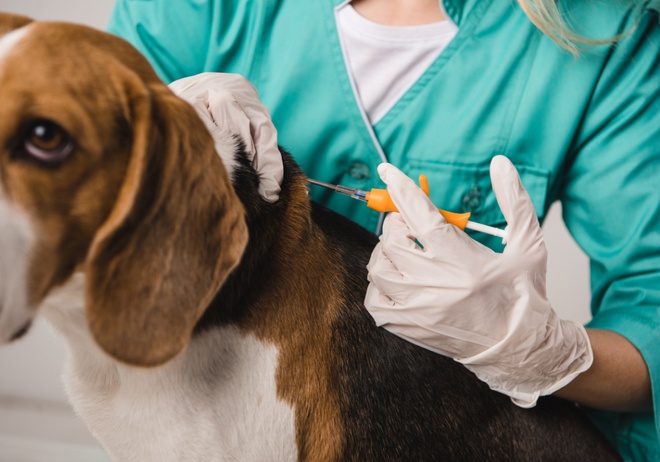What is microchipping a dog or cat?
What is microchipping? How does it work? What are the advantages and disadvantages of microchipping? This is what we will discuss in this article.

Reading time : 4 min
TOPICS
A pet is part of our family. However, unlike a human family member, dogs and cats tend to wander or run away and get lost. To ensure that you never lose track of your furry friend, there are some things you can do.
One of the options is of course to provide your companion animal with a collar or a tag, but they can get caught or removed. There are no such worries with a microchip: a microchip implant is a permanent identification system.
What is a pet microchip?

A microchip is a small electronic chip encased in a biocompatible glass. The chip is about the size of a grain of rice and is implanted between the shoulder blades. The injected chip contains a unique code, or serial number, that corresponds to your pet’s details.
The serial number is registered on a microchip database registry with details about the animal and his owner. The microchip does not contain your emergency contact information. It only contains your unique identification number, which is used to access your paperwork.
Pet owners should ensure that their details are registered in the database in which their pet's microchip number is recorded, so they can be contacted easily. Should your pet become lost, vets or animal shelters can scan your pet for a microchip and contact you via the database.
Understanding how a microchip works

A pet microchip is a radio frequency identification transponder, but this radio frequency chip is not a data transmitter. It is only activated when a specific scanner is used. A chip can usually emit three different frequencies and some scanners can only scan one of them. However, universal scanners are used most of the time.
When a microchip scanner is passed over the skin of a microchipped animal, the implanted microchip emits a radio frequency signal. The scanner reads the unique identification number of the microchip. The microchip database is called and will use the ID number to retrieve the pet’s owner’s details.
The same system is used for public transport tickets. They are equipped with an RFID tag that contains the access rights of the card owner. The user of the transport network inserts his ticket or approaches his badge to an RFID reader terminal to validate his journey.
Whose responsibility is it to microchip a puppy or a kitten?

All dog breeders have the responsibility to ensure that puppies are microchipped before they are sold. Puppies cannot be sold before they are eight weeks old and must be microchipped before they are sold.
Breeders must also register their details on the database. Any person owning a dog or cat which gives birth is considered a “breeder”, regardless of whether they carry on a business as a breeder of pets or not. When the dog is sold, it will be up to the new owner to keep the contact information up to date. He will then have 21 days from the date of the change of keeper to do so.
If a rescue centre recovers an abandoned dog that isn't microchipped, they will probably chip the dog. Again, the new owner will have to keep the registration information up to date.
Is it a legal requirement to get your pet chipped?

What the law says
In the UK and in Wales, you must ensure that your dog is microchipped before it is eight weeks old. With new legislation due to be passed in 2023, cat owners will have to microchip their pets before they reach the age of 20 weeks. Non-compliant keepers, will have 21 days to have one implanted, or may face a fine of up to £500.
The microchip could be a lifesaver
But dog identification is not just a legal obligation. It is also a moral duty, because having your dog or cat identified is also a way of protecting it and therefore of being aware of the responsibilities that this implies. Identification of the pet allows a fall-off in losses, offering on average 40% more chances of finding it.
What are the pros and cons of microchipping your pet?

Advantages of microchipping your dog or cat
There are many advantages to having your pet microchipped, including the following:
- Helps to find your lost pet more easily.
- You will never have to replace the microchip, as it lasts a lifetime.
- The embedding process is quick, and the microchip is easy to install. Unlike a tattoo, your pet doesn’t have to be wrestled to the ground or shaved to get identified.
- An embedded microchip cannot be tampered with, unlike tags and collars, which can break or be removed.
Disadvantages of implanting your pet a microchip
Although dog and cat microchipping have no real disadvantages, there are a few things you should know about the procedure.
- There is a tiny risk for your pet to develop inflammation around the injection. In the worst cases, this may cause a tumour. However, these cases are extremely rare.
- You have to update the registration information on the microchip every time you change your address. Owners easily forget these details.
- Sometimes the microchip moves away and migrates from the injection site, making it more difficult to locate and scan it.
- Microchips are passive transponders, which means that they do not track the pet’s whereabouts. They therefore do not act as a GPS.
- It is not easy to tell whether a dog or cat is microchipped.
Conclusion
The functioning of the microchip is not complicated to understand. This small chip about the size of a grain of rice only contains the identification number. Your personal information is kept safe in the database in which you have registered.
A microchip implant is a simple, painless, and effective way to ensure that your pet is identified if he ever does run off from home.
Continue reading our guide
This article is part of a complete guide on the subject. Do not miss the next chapters.
Are you an expert on pet microchipping?
Test your knowledge!
Answer our 7 questions on pet microchipping.
